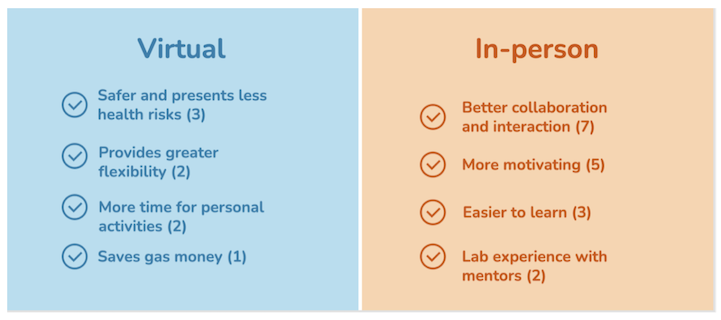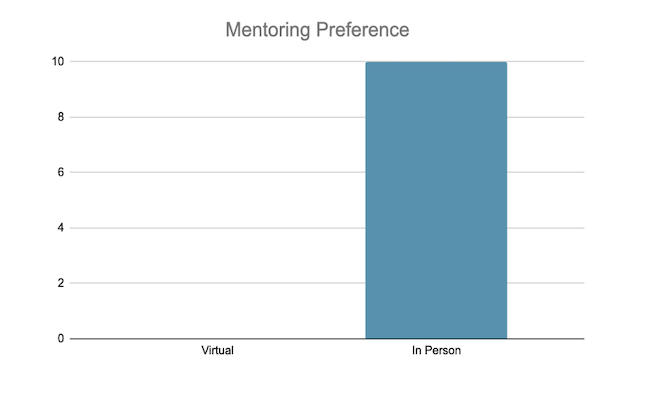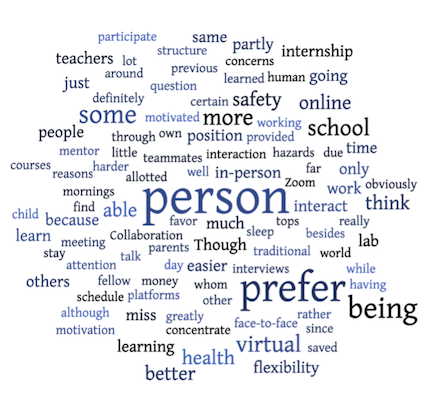During the 2020–2021 academic year, the Werner H. Kirsten (WHK) intern cohort experienced the first entirely virtual WHK program. Our classes became Zoom meetings, our bedrooms became offices, and we traded paper and pencil for a keyboard and mouse.
Traditionally, the WHK internship program gives high school students who hope to gain firsthand experience in the field the opportunity to work alongside mentors and professionals at NCI. This year, however, the only option was to pivot to a remote internship because of the pandemic.
Given the uniqueness of the situation, we, Yasmine Zouhairi and Leslie Hilares, interns working with mentor Cathleen Cullen in NCI’s Education Outreach Program, felt it was important to collect data about the changes in our scientific education and what it could mean for the future of learning. We wanted to combine our passion for science education with the professional skills that we had been developing throughout the year. This project was the perfect way to do that.
We created an anonymous virtual questionnaire, directed at interns and mentors, with questions about the impacts of an entirely remote program this year.
Our queries yielded information about the interns’ and mentors’ feelings about their experience, where they faced challenges, unexpected benefits, and even suggestions they had for the future.
Student Views: Struggles and Silver Linings
The interns’ responses were generally in accord. Seventy-three percent of interns felt the virtual learning model worked well for them, even providing some unexpected advantages. The biggest advantages named were being able to create their own schedule, having more research time, and the ability to attend a wide variety of seminars.
But there are two sides to every coin. While virtual learning may have provided flexibility, interns ultimately felt it lacked quality social interaction, made collaboration difficult, and decreased learning engagement.
“The virtual learning model has worked well, but it has also made it hard to connect with others in the lab and with other WHK-SIP students,” said one laboratory intern. They weren’t alone in their feelings: 83% of interns concluded that they prefer in-person learning over virtual.
There’s no doubt that students have faced a huge decline when it comes to social interactions and peer collaboration. When asked about suggestions for improving the program, 30% of respondents recommended more opportunities for interaction. One intern concluded that more communication between interns would be “more exciting” and said, “I’d love to talk to the other interns outside of lectures and club activities.”
Mentor Perspective: Areas for Improvement
The mentors seemed to agree, with 100% answering that they prefer in-person mentoring to the virtual alternative. One mentor commented, “The inability to sit down with our intern in person makes it difficult to provide quality feedback.”
Because interaction required a virtual meeting to be scheduled, mentors felt it was harder to provide thorough guidance and gauge a student’s progress in the remote setting.
The interns faced yet another challenge according to mentors: “missing out on the summer [portion of the] internship, which usually is a very intense and important time to get the students introduced into the subject matter.” The foundation to the internship was much different this year compared to others.
Normally, WHK students spend the summer months training on-site prior to their internship, where they learn more about the material and laboratories they will be working with. The pandemic restrictions made that impossible this year, so mentors had to improvise the training for interns at the beginning of the school year.
Mentors would like to see more initial training for the interns in the future and more technology resources if the program continues to be virtual. Regardless, they all agreed that the interns did a great job working around these challenges.
Learning from a Challenging Success
Our project’s data reflects the virtual program’s outcomes and is important for future years. Our work has been shared with local program specialists, directors, and internship coordinators.
A virtual WHK internship had never been done before, and this year clearly tested the resilience of the program. Yet within the challenges, novel ideas arose, new learning methods were developed, and creativity was put to the test. One mentor summed it up perfectly: “We took it on as a challenge and, honestly, it was a resounding success.”






